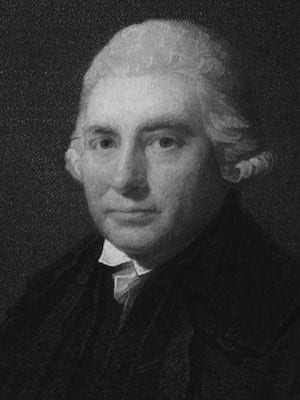Alexander Monro secundus

Alexander Monro secundus (1733-1817) was a Scottish physician and anatomist.
Most notable contributions include works on the lymphatic system, the interventricular foramen (of Monro), and the Monro-Kellie doctrine
Significant work on comparative anatomy in his 1785 book The Structure and Physiology of Fishes Explained and Compared with those of Man and other Animals
Biography
- Born 22 May 1733 in Edinburgh, son of Alexander Monro Primus.
- Educated at ‘Mr Mundell’s School’ before attending the University of Edinburgh. First appearing on lecture records in 1744 aged just 11 years old.
- Initially studied the classics and basic sciences before formally starting medical studies around 1750.
- By 1753 Alexander Monro Secundus was teaching anatomy classes, entrusted by his father, then professor of anatomy.
- Appointed Professor of Anatomy in July 1755 prior to completing his MD in October of the same year.
- Studies continued in London, attending lectures by William Hunter, another eminent Scottish anatomist, before travelling to Berlin where he studied under Professor Meckel (Johan Friedrich the elder).
- Returned to Edinburgh in 1758, appointed fellow of Royal College of Physicians of Edinburgh in 1759.
- Primarily an educator, delivered a full course of lectures between 1759 and 1800 at Edinburgh before his son Alexander Monro Tertius took over.
- Suffered an ‘apoplectic attack’ in 1813, though survived another 4 years before dying in October 1877.
Medical Eponyms
Monro-Kellie doctrine (1783)
The sum of volumes of brain, cerebrospinal fluid (CSF) and intracerebral blood is constant. An increase in one should cause a reciprocal decrease in either one or both of the remaining two. Monro noted that the brain is enclosed in nonexpandable bone and is nearly incompressible; and that the volume of the blood in the cranial cavity is constant or nearly constant; and that continuous venous blood outflow is required to make room for continuous incoming arterial blood
Interventricular foramen (of Monro) (1783)
The communication in the brain connecting the lateral ventricles to the third ventricle. Monro stated that “..these cavities have been described by Galen, and by many succeeding Authors of eminence, as all communicating with each other” but Monro provided a more detailed (if not completely accurate) description to yield eponyminity
Key Medical Attributions
Monro postulated that the toxic influence of opium was primarily caused by effects on the nervous system and not the vascular system as previously described by the Italian toxicologist Felice Fontana (1730–1805)
…and now conclude, that opium and other poisons, even after they are mixed with the mass of blood, produced their fatal effects, chiefly and almost solely, by acting on the nerves of the heart and vascular system, and through these, affecting the whole of the nervous system
Monro 1793
Controversies
The Monro Bell Controversy
Monro’s description of the interventricular foramen encountered resistance from other well-known anatomists of his time. In particular from Sir Charles Bell in 1802. Bell criticized Monro for presuming to describe something which was already well known and for inaccuracies. Bell Stated ‘‘there is scarcely a book which we can consult without finding the circumstance of the universal communication betwixt the Ventricles particularly mentioned.’’
Furthermore, Bell would ridicule Monro’s work when teaching students and reportedly would push a blow pipe through the parietes of the ventricles, and exclaim, ‘‘This is the foramen of Monro!’’
Monro disputed this attack, although his anatomical description was shown by later anatomists to be mistaken. He wrote in 1797:
…in 1783, when I published my book upon the Nervous system, I gave such a full description of the Communications of the Ventricles of the Brain, illustrated by figures, that I did not suppose any person, who pretended to anatomical knowledge, could find difficulty in tracing by direction all I had described.
To my very great surprise, however, I have been informed, that several Teachers of Anatomy in London have told their Pupils, that they had looked for such passages in vain; and therefore ventured to deny their existence.
Monro 1797
Ad Vitam aut Culpam Medical dynasty
The medical lineage of the Monro family: 3 generations with the same name, with each in turn occupying the Chair of Anatomy at the University of Edinburgh
Alexander Monro primus (1697–1767)
- Professor of Anatomy at the University of Edinburgh (1720)
- Key role in founding the University of Edinburgh School of Medicine and the Edinburgh Royal Infirmary
- Major work: The Anatomy of the Human Bones and Nerves running for 8 editions from 1732 to 1775
- Secured Ad Vitam aut Culpam (for life or until fault) position as Professor when he argued “…by taking away the least umbrage of uncertainty in the Office will likewise remove all pretences for neglect of duty in the exercise of it…”
Alexander Monro secundus (1733–1817)
- Succeeded his father as Professor of Anatomy at the University of Edinburgh
- Most notable contributions include works on the lymphatic system, the interventricular foramen (of Monro), and the Monro-Kellie doctrine
Alexander Monro tertius (1773–1859)
- Succeeded his father as Professor of Anatomy at the University of Edinburgh
- Significant works and insights into abdominal aortic aneurysms and the anatomy of the genitourinary system
Major Publications
- Monro A. Observations, anatomical and physiological. 1758
- Monro A. De venis lymphaticis valvulosis et de earum in primis origine. 1761
- Monro A. Observations on the structure and functions of the nervous system. Edinburgh 1783. [Monro-Kellie doctrine] [Foramen of Monro]
- Monro A. A description of all the Bursae mucosae of the human body. 1788
- Monro A. Description of a human male monster. 1792
- Monro A. Experiments relating to animal electricity. 1792
- Monro A. Experiments on the nervous system with opium and metalline substances. 1793
- Monro A. Three treatises : On the brain, the eye and the ear. 1797 [Foramen of Monro]
- Monro A. The works of Alexander Monro primus, M.D. Fellow of the Royal Society, Fellow of the Royal College of Physicians, and late Professor of Medicine and Anatomy in the University of Edinburgh. 1781 [Published by his son Dr Alexander Monro secundus]
References
- Ravitch MM. Invective in surgery: William Hunter versus Monro Primus, Monro Secundus, and Percival Pott. Bull N Y Acad Med. 1974 Jul-Aug; 50(7): 797–816.
- Pearce JM. The Monro Bell controversy. Clin Anat. 2013 Oct;26(7):793-9
- Wu OC, Manjila S, Malakooti N, Cohen AR. The remarkable medical lineage of the Monro family: contributions of Alexander primus, secundus, and tertius. J Neurosurg. 2012 Jun;116(6):1337-46
- Patel K, Mishra P, Choudhari KA. Commentary: Alexander Monro of “The Foramen of Monro”. Neurosurgery. 2018 Oct 1;83(4):E146-E152.
Eponym
the person behind the name
Studied at the University of Oxford - BA BM BCh. British doctor working in Emergency Medicine in Poole, Dorset. Special interests include respiratory medicine, critical care, and wilderness medicine.

